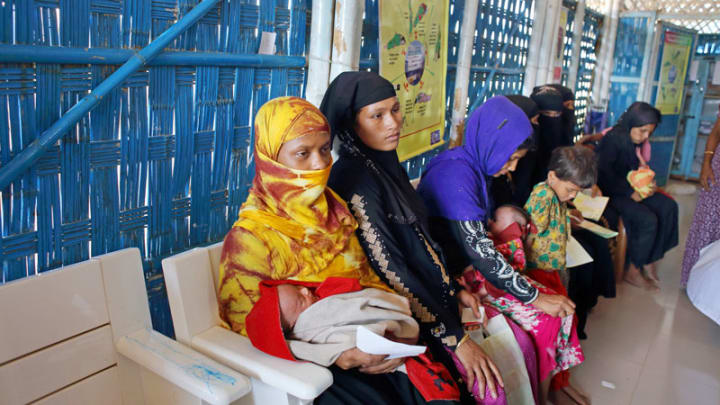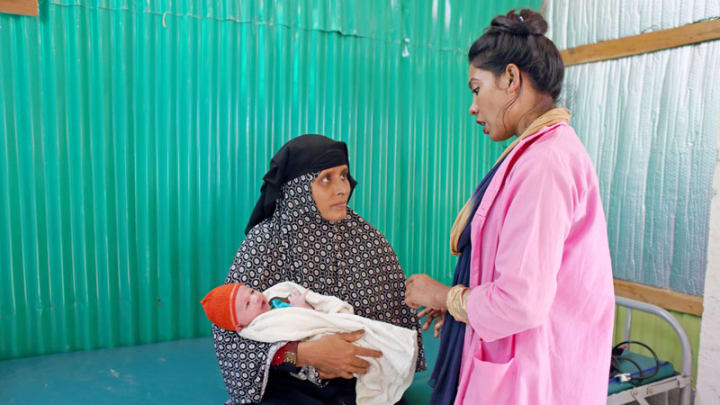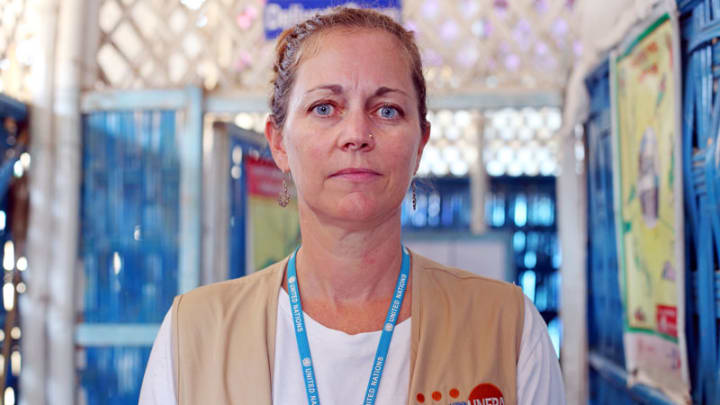
COX’S BAZAR, Bangladesh — It’s late afternoon, and the crowd of Rohingya women waiting at the Hope Field Hospital for Women in Kutupalong refugee camp has slowly trickled away.
Dolly Mondal, a 23-year-old midwife, smiles encouragingly when she sees Sajida Begum arrive with her baby. A week ago, she helped Sajida deliver her seventh child. After she examines the baby, Mondal asks the 30-year-old mother if she would consider using contraceptives, a largely taboo subject for conservative Rohingya, who consider children divine blessings. Sajida quietly responds that she does not want any more children.
The young midwife, whose air of assurance belies her age, hands Sajida a strip of tablets and advises her how to use them.
All of Sajida’s children were born at home in Myanmar’s Rakhine State; this is the first baby she has delivered in the refugee camp she fled to with her family in August 2017.
“I was afraid to go to the hospital. I had never been to one before. But Allah wanted me to go,” Sajida said. “They took good care of me and everything was very clean.”
More on Cox’s Bazar:
► 700 words and expressions to help aid workers communicate with Rohingya refugees
► Aid groups adapt Rohingya mental health services for population in limbo
She knows of no other woman from her community who has given birth in a hospital, but added that she would recommend it: “The women in pink coats were very kind.”
Pink is the color of the uniform worn by midwives in Bangladesh. In 2010, Bangladesh, a country that has long struggled with a high rate of maternal mortality, committed to introducing midwifery into its health system. The first class of trained midwifery professionals graduated in 2015 following a three-year specialized course provided by the government of Bangladesh and the United Nations Population Fund. Many enthusiastic young midwives have since been called to the frontlines of the humanitarian crisis in Cox’s Bazar — where they’re practicing their skills in a context equally complicated for pregnant women and the health professionals who serve them.
Each day, a new challenge
UNFPA’s primary health center, located on top of a hill in the middle of the vast camp, is one of the busiest health facilities in the Kutapalong refugee settlement. The U.N. agency supports 23 clinics and 19 women-friendly spaces in the camps, with 120 midwives deployed across them.
“Midwives are the primary providers for the women that come in. But there are challenges in being here in the middle of this huge camp where our resources are somewhat limited,” said Diana Garde, midwifery consultant at UNFPA, who works as a mentor to the midwives posted in Cox’s Bazar.
One of the complications in establishing the midwifery profession from the ground up has been the lack of midwifery educators in the country. Like UNFPA, which has recruited Garde and other maternal health experts to work in the camps, many health facilities serving women in the camps work with a pool of international midwives to mentor the newly trained women.
For Mondal, who was assigned as a midwife to the world’s largest refugee settlement just after she graduated midwifery school in early 2018, each day brings new challenges.

“I did not know what midwifery is when I signed up, and I wanted to quit,” said Mondal, who is the first woman in her family to leave her home and work. “But when I saw a woman give birth for the first time and saw how powerful that moment is, I felt it’s a job which is important.”
And in the refugee camps that trail along southern Bangladesh’s border with Myanmar — where Mondal now finds herself — the maternal health needs are staggering.
Since August 2017, more than half of the nearly 700,000 refugees that fled heightened violence and persecution in Myanmar are women and children. Nearly 48,000 babies were expected to be born in the camps in 2018, according to a January 2018 report by Save the Children. In overcrowded settlements now home to nearly 1 million Rohingya, many of these births take place in a family’s shelter with a high risk of exposure to diseases.
Yet most Rohingya women are afraid to enter hospitals or are forbidden by their families: “I’ve heard that they take away your babies in hospitals or kill them,” said Hussain Ara, a refugee who is pregnant with her fourth child.
As a result, the midwives deployed in Cox’s Bazar must earn the trust of the Rohingya who were denied access to health information and services in Myanmar.
Mondal, who works six shifts a week at Hope Hospital and lives in a hostel for midwives near the camp, spends much of her day speaking with women and educating them on their choices.
“A big part of my job is to counsel women, telling them there’s no shame in being here among other women,” she added.
Making a difference
“The women in pink coats were very kind.”
— Sajida BegumA shortage of 24-hour health facilities capable of handling basic emergency obstetrics combined with the hilly terrain of the camps further complicates access to medical facilities — particularly for pregnant women. Rohingya mother Mansura Begum, for example, visited a clinic for her prenatal checkup in the morning and went into sudden labor at home later that afternoon.
“The pains started with the Asr and by Isha, the baby was born,” the 30-year-old mother said, marking the events using the late afternoon and night time prayers. “I couldn’t reach the hospital.”
In these cases, most Rohingya women deliver under the care of dais, or traditional birth attendants, who are often older women in the community with knowledge that has been passed down through generations. But without access to modern medical knowledge and resources, their practice can be both dangerous and unhygienic.
“Nobody taught me how to help a woman give birth. This skill is God’s gift,” said Dildar Begum, a former traditional birth attendant who has given up her role to be a community health worker with Hope Hospital. UNFPA and several other aid agencies have recruited traditional birth attendants to work in the field, gain the trust of the community, and help explain to women why they may wish to visit clinics.
“They are a very essential link from the community to the facility,” Garde said. “They are able to reach the women in their homes, encourage them to come in and not be afraid or shy, to teach them what to what to expect in the facility.”
August 2019 will mark two years since the exodus of refugees into Bangladesh, and aid agencies and health workers are recalibrating their response to the crisis.

“We’re moving from an emergency to a more long-term response, looking at not just the things we need to do urgently, but the things we need to cover in women’s health,” Garde said. “We need to screen women as they come in, collect more data. So, we’re looking at things like fistula among Rohingya, which has so far been undiagnosed.”
UNFPA is also working with the Centers for Disease Control and Prevention to develop a maternal mortality surveillance system for the camps, which would allow them to collect data on maternal mortality in Cox’s Bazar specifically for Rohingya refugees — numbers they expect to be higher than the rest of the country.
In the meantime, it is the challenge of the work that inspires many of the young midwives on the frontline: “I feel I can make a difference, save lives,” Mondal said, as her shift ends and she hands her duties over to the next midwife.
Editor’s Note: This reporting was supported by a grant from the European Journalism Centre, with funding from the Bill & Melinda Gates Foundation. Devex retains full editorial control and responsibility for this content.


